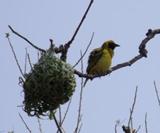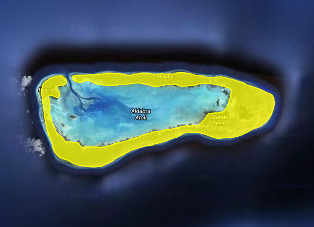Weaver species
Choose different species from drop-down list and press 'Go' button. See Full species list.Aldabra Fody Foudia aldabrana
IUCN: Least concern Discovery: 094Categories: island, Foudia, fruit, nectar, palm,
News items about species
Discovery
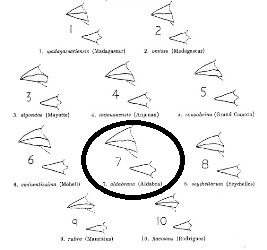
figure from Moreau (1960) 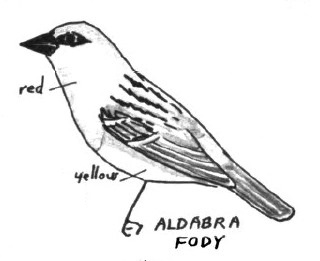
figure from Watson (1963) 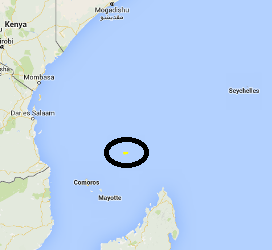
distribution, type locality circled IntroductionThe Aldabra Fody was formally described by Robert Ridgway, an American ornithologist specializing in systematics, describing a large number of new species, and curator of birds at the United States National Museum.The Aldabra Fody was collected by William Louis Abbott, an American medical doctor, explorer, ornithologist and field naturalist. He complied many collections of biological specimens from around the world, especially from southeast Asia, and was a significant financial supporter of the United States National Museum collecting expeditions. Dr. Abbott visited the inner Seychelles from March to May 1890. He then sailed to Aldabra, Assumption, the Amirantes, Ile Glorieuse, and other islands northwest of Madagascar, from July 1892 to January 1893, collecting 205 specimens on these islands. He wrote a letter from Mahe, Seychelles, in March 1893: "Aldabra proved quite interesting. I renmined there three and a half months, and obtained specimens of all resident species. There are fourteen land birds resident, and I picked up six others that were evidently 'passers-by.' Also obtained nests and eggs of most of them." Abbott wrote the following about the Aldabra Fody: "A very common species in Aldabra. Nesting in November, December, and January. Builds in casuarina trees, generally near the seashore. Nest made of casuarina needles, somewhat loosely constructed, oval in form, roofed over, with the entrance in the side and suspended from the end of a branch. Number of eggs four. The male assists in the construction of the nest, but not in incubation (?). These birds are very fond of the seeds of the casuarina tree and are also destructive to unripe maize. They are, however, apparently only able to reach the latter after the husks have been gnawed through by rats. They are very tame and familiar, coming in flocks to feed on the crumbs and scraps about the houses." The first illustration including the Aldabra Fody was of the bill shapes of fodies, published by Moreau (1960), many decades after the species was first described. The next illustration was a line drawing of the male in Watson (1963). Scientific citationFoudia aldabrana Ridgway 1893a, Proc. U.S. Nat. Mus., 16, p.258, Aldabra Island.Meaning of namesaldabranus, Named after the Aldabra Atoll in the Indian Ocean.First English nameAldabra Fody (Shelley 1905b).Alternate namesCardinal, Red-headed Forest Fody, Serin, Toq Toq.CollectorWilliam Louis Abbott.Date collectedOct 1892.Locality collectedAldabra Island.Type specimensFive types are in the US National Museum. |
The above is based on Weaver Wednesday 2, a weekly series about the discovery of each weaver species.
This species text first appeared as
Weaver Wednesday [211] - Discovery [94]: Aldabra Fody on 2016-06-29
1. Basic biology
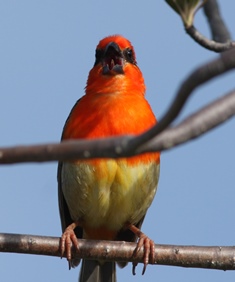
copyright Ross Wanless 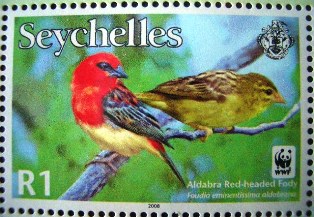
The non-breeding male and the female are dull coloured, but there are no other weavers or fodies on Aldabra. The bill is long and heavy compared to other fodies. Distribution. The Aldabra Fody is restricted to Aldabra atoll in the Indian Ocean (see map below, based on Birds of the Malagasy region). It occurs on the main islands and on the small islets inside the lagoon. The population is estimated at 1000-3000 pairs.
Habitat. The Aldabra Fody inhabits all woody habitats, including scrub, mangroves, Casuarina woodland and coconut groves. At the settlement it is tame and enters the houses. It often occurs in flocks. Food. The Aldabra Fody is omnivorous, and eats insects, spiders, seeds (including Casuarina and grass seeds), nectar, fruit and flowers. Insects include beetles, cockroach adults and nymphs, adult damselflies, termites, earwigs, ants, grasshoppers, and flies. The large bill of the Aldabra Fody allows it to take larger insects than other fodies do. Breeding.
The Aldabra Fody is monogamous and territorial. The male sings in his territory to defend it. The male builds the nest, although the female may help when it is near completed.
The nest is globular and has a side entrance, resembling the nest of other fodies, and the nest sometimes has a short porch. The nest is placed in trees (especially Coconut Palms) or shrubs, often high above the ground. Nests may sometimes be built in the palm thatch of buildings. Nest material includes tendrils, strips of palm fronds, dry grass, dead leaves, and other vegetation. Fine grasses are used to line the nest. Many nests are abandoned, probably if a male fails to attract a female. Males build up to 10 nests in a breeding season. Nest construction varies from 3 days to a few weeks. The eggs (usually 3, but varies from 2-4 eggs) are pale blue. Incubation is by the female, and chicks are fed by both parents. Breeding success is low, and nest predators include rats and Pied Crows. |
The above is based on Weaver Wednesday, a weekly series about weaver species.
This species text first appeared as
Weaver Wednesday [117]: Aldabra Fody on 2014-09-10
2. Breeding facts
| Pair bond Monogamous Breeding season Nov-Apr on Aldabra Nest site suspended rarely 1 m above ground, most often higher than 10 m Nest building Male starts nest and, once female has accepted it, both sexes build, and female may complete the structure with little male participation Colony size No information Clutch size 2-3 eggs Egg colour pale blue-green, occasionally few black specks Egg size average size of 45 eggs 20.1 x 14.3 mm (Aldabra) Incubation incubation by female only, period 13-16 days Chicks and nestling period chicks fed by both parents, male usually began feeding only after 3 days, nestling period 15-18 days |
Breeding information based on Handbook of the Birds of the World, Vol. 15.
3. Photos of Weaver Nests
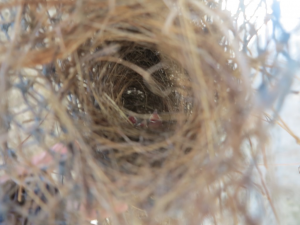 Vm 20405 | 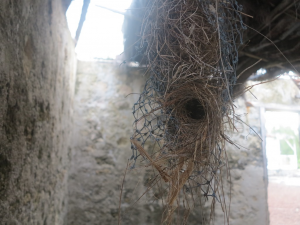 Vm 20404 |  Vm 20403 |  Vm 20402 |
Thumb-nails of most recent PHOWN records - click on one to see its full record
See all PHOWN records for this species here.
PHOWN (Photos of Weaver Nests) provides valuable info on breeding distribution and colony sizes of weavers.
You can contribute by registering and submitting photos at Virtual Museum webpage.
4. Breeding distribution
Google map showing distribution (For species with small ranges you need to zoom in at the correct area to see the range):
yellow blob - range of weaver species; read more about this here.
![]() - PHOWN records with photos
- PHOWN records with photos
![]() - PHOWN records with no photos (Nest Record Cards, other records)
- PHOWN records with no photos (Nest Record Cards, other records)
![]() - Birdpix records
- Birdpix records
![]() - comments on out of range records, or interesting records
- comments on out of range records, or interesting records
![]() - type locality
- type locality
CLICK on the marker on the map to see individual record details.
5. Range changes
Not South African speciesThe above is based on Weaver Wednesday 3, a weekly series about range changes in South African weaver species.
This species text first appeared as
n/a








